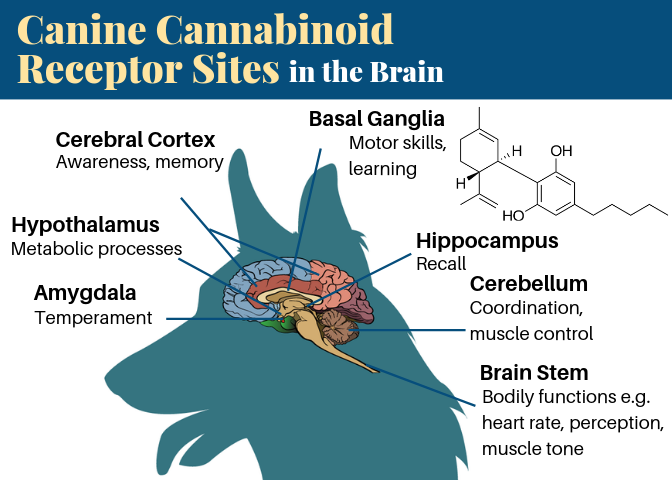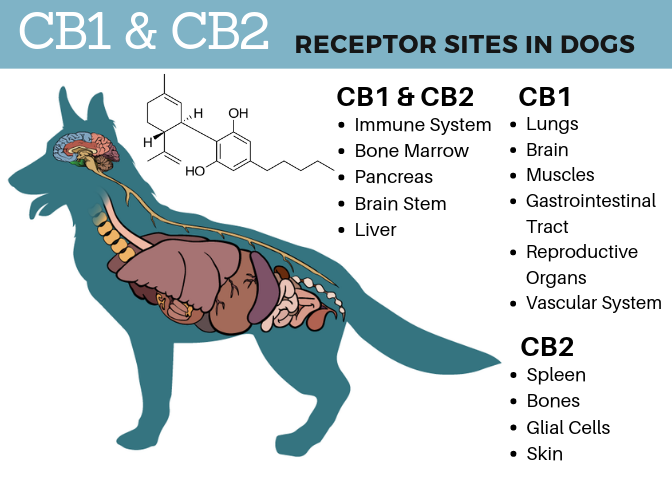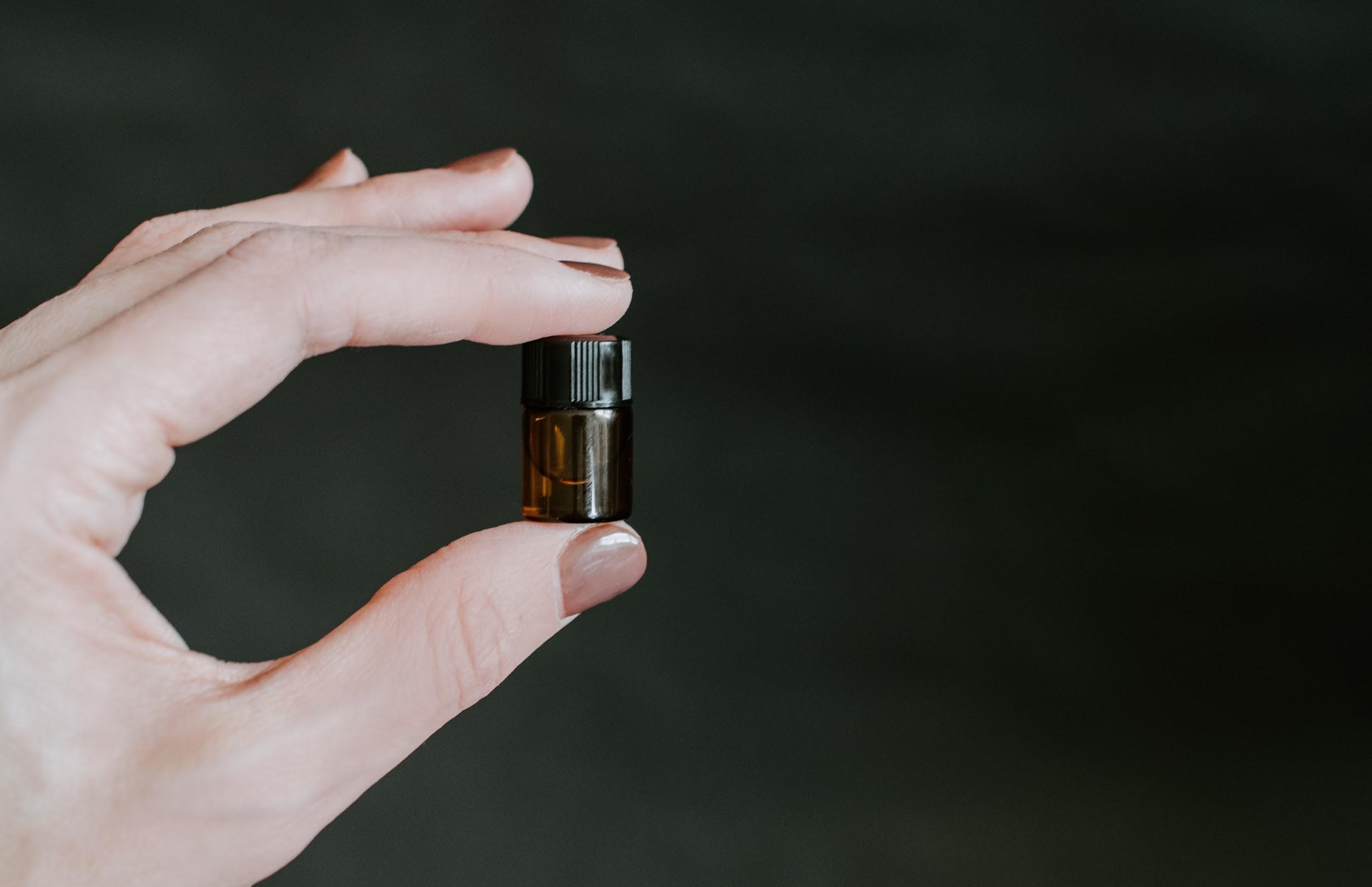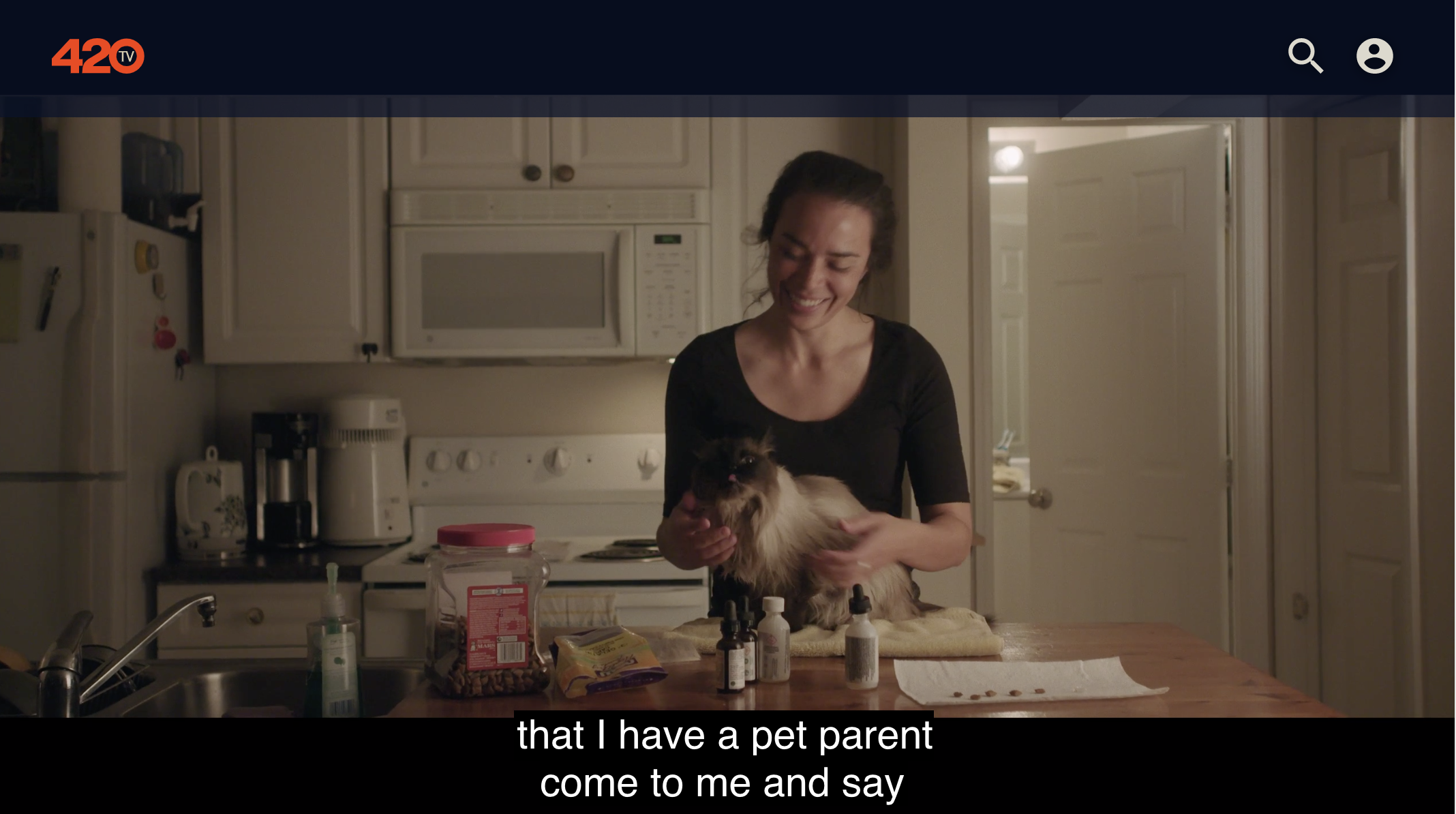Is it Okay to Give CBD to Cats and Dogs?
We love our pets, and when it comes to making decisions about their health, we want to be informed. Normally, we can turn to our veterinarian for advice, but what about the topic of cannabis?
Is CBD Okay to Give to Pets?
CBD has become quite the buzzword. The once stigmatized cannabis plant is now the subject of interest in science for its many promising medical applications. Pet boutiques and dispensaries are burgeoning with “all-natural” treats made with CBD for dogs and palatable cannabis oil for cats, but legal restrictions prevent veterinarians from prescribing and even discussing their use.
According to a poll by the Veterinary Information Network, 8% of veterinarians are asked about cannabis products daily and 29% get asked weekly—but the legal ambiguities of the cannabis industry leave pet owners confused and seeking answers. Meanwhile, anecdotal evidence in support of CBD use is great, but what does the science say? Can CBD help pets, and how?
“Animals and cannabis plants have always integrated for thousands of years, but it’s exciting to see the end of the era of prohibition on cannabis and medicine utilizing all of the benefits, all the research, and providing the world the efficacy and benefit of the molecules in this plant.”—Stephen Cital, RVT
What Is CBD?
The cannabidiol (CBD) molecule is just one of over 100 known cannabinoids found in Cannabis sativa L., the same plant that is cultivated to produce hemp strains and marijuana or THC-containing strains. These cannabinoids interact with the system that modulates pain and attenuates inflammation in all animals: the endocannabinoid system or ECS. Unlike THC, which produces a “high,” CBD is non-inebriating.
What Is the Difference Between Marijuana and Hemp-Derived CBD?
In 2018, the Farm Bill was signed into law and hemp was removed from the list of controlled substances under the formal definition of Cannabis sativa L. with <0.3% THC based on dry weight. But marijuana remains classified as a schedule I drug (like heroin and LSD), which means that it is federally illegal and has “no therapeutic benefit.”

How Does the Endocannabinoid System Work in Dogs and Cats?
Both CBD and THC have numerous physiological effects in vertebrates thanks to the ECS. This means that dogs, cats, birds, rabbits, horses, etc. all have an endocannabinoid system similar to humans. There are two types of cannabinoids that interact with this intricate system: phytocannabinoids (produced by the cannabis flower) and endocannabinoids (naturally produced by all vertebrates).
Phytocannabinoids mimic endocannabinoids in the ECS, which is why cannabidiol or CBD may help to maintain homeostasis in dogs and cats by regulating the following:
- Balance and coordination
- Appetite
- Digestion
- Pain and sensation
- Mood
- Cognition
- Immune system functions
- Cardiovascular system functions
- Reproduction
- Sleep

CB1 and CB2 Receptors
Within the ECS, cannabinoids trigger signals throughout the central and peripheral nervous system of small animals and relay messages from the brain and to the body via CB1 and CB2 receptors:
- CB1 receptors are generally found in the central nervous system (the brain and spinal cord) and in the liver, gut, adrenals, cardiovascular system, and the region of the brain responsible for managing fear and anxiety.
- CB2 receptors are primarily localized in the immune cells and are thought to promote relaxation and pain relief by reducing inflammation.
These CB1- and CB2-acting compounds vary greatly in their ability to maintain homeostasis in the body—some work on the joints and control pain, and some may regulate mood and reduce anxiety.

“I think the presence of our endocannabinoid systems is evolutionary proof that we are designed to utilize these molecules . . . . It’s such a cool place to be in the forefront—to show we are learning.”—Liz Hughston, RVT
What Are the Health Benefits of CBD in Pets?
Preliminary studies show that CBD has great potential for usefulness in small animals like cats and dogs, and researchers are just beginning to tap into the properties of cannabinoids and volatile terpenes. These compounds can be isolated for “target support” to work on different pathways in the body or even combined to work synergistically for a variety of conditions like epilepsy, chronic pain, anxiety, allergies, inflammation, and even cancer.
Will CBD Help With Pain Relief for Pets?
The preliminary data is encouraging. In 2018, Frontiers in Veterinary Science published a groundbreaking study by Cornell University College of Veterinary Medicine and ElleVet on the safety and efficacy of CBD for multi-joint pain in osteoarthritic dogs. The clinical findings revealed that 2 mg/kg of CBD twice daily can actually help to increase comfort in dogs suffering from osteoarthritis.
According to a Cornell-ElleVet study, “2 mg/kg of CBD twice daily can help increase comfort and activity in dogs with OA.”
Cannabidiol may offer an alternative approach to how pain is managed in geriatric patients. “Side effects are less severe and detrimental than traditional pharmaceuticals . . . [and] there’s a lot of exciting things coming out on cancer research, either in alleviation of treatment-related symptoms and possibly staving off growth” adds Stephen Cital, RVT and Director of Education and Development at ElleVet Sciences.
Does CBD Work for Older Dogs and Cats?
Chronic conditions like inflammation, low appetite, impaired cognition, anxiety, and end-of-life discomfort could be more comfortably managed with CBD. Cannabidiol may even improve the efficacy of certain drugs and could allow for an overall reduction in drug dosing for these conditions.
Traditional modes of pharmaceutical therapy and treatments for age-related disease in pets can be hard on the body. Geriatric patients are commonly treated with anti-inflammatory drugs (NSAIDs) for chronic conditions like osteoarthritis, but these medications may compromise major systems and organs like the kidneys and GI tract.
The Potential Benefits of Cannabis Oil in Pets
Mother Nature’s been doing things a lot longer than we have . . . I really like the formulation she’s done with the cannabis plant—whether hemp or marijuana. People want a natural product, and when we have a natural product, we have [fewer] side effects.”—Stephen Cital, RVT
Is CBD Harmful and What Are the Side Effects in Dogs and Cats?
CBD is thought to have a large margin of safety, but it can interact with and potentiate certain medications, especially those metabolized by the liver. Moreover, lethal doses in cats and dogs have not been confirmed and the FDA has yet to establish the potency, purity, or biological activity of any of the current CBD products on the market. Many products are severely over- or under-labeled, which can put animal companions at risk. Cital explains the importance of researched-backed products: “[We are] evaluating companies’ product profiles all the time, to ensure a safe and effective product and to really lean on companies that have funded scientific studies.”
Unregulated products may be spoiled or contaminated with chemicals like acetone or contain higher levels of THC than known which will certainly harm pets. This is also why human cannabis oils and products cannot and should not be used on animals; similarly, humans should not consume pet CBD products.
It’s also important for owners to be able to identify the side effects of cannabis toxicity in dogs and cats. If a pet ingests too much CBD, symptoms like wobbling, respiratory depression, behavioral changes, and dulled mentation may be observed, but THC toxicity in dogs and cats is much more serious.
Cannabis should not be used in young animals or animals that are pregnant or nursing.
Is Cannabis Toxic to Dogs?
While trace amounts of THC are often negligible, large quantities of THC and common ingredients in cannabis products like chocolate, raisins, and xylitol are toxic to dogs and cats. Pets that have ingested THC-containing products or those that are exhibiting signs of toxicity require veterinary care. How can you tell if your pet has ingested too much cannabis?
Signs of Cannabis Toxicity in Dogs and Cats
- Ataxia (lack of muscle control)
- Incontinence
- Vomiting and diarrhea
- Anxiety
- Lethargy
- Slowed breathing
- Slow pulse or cardiac rhythm
- Noise and light sensitivity
- Unresponsiveness
- Seizure
- Coma
Will Marijuana Kill My Dog or Cat?
To date, there have been no confirmed cat or dog fatalities due to cannabis ingestion; any pet deaths that have been attributed to cannabis were likely caused by the simultaneous ingestion of toxic substances. Cats and dogs that become unresponsive and comatose after ingestion are particularly at risk of deadly aspiration pneumonia.
In the event of an overdose, it is important to communicate with your veterinary care team; bring in any wrappers that list the ingredients and the amount of THC in the products that were ingested. (Veterinarians are not mandated to report drug intoxications.)

What Are the Best CBD Products for Pets?
It’s important for owners to know that pet CBD is marketed in both hemp-derived and marijuana-derived forms:
- Hemp-derived forms are often sold in pet shops, pet boutiques, or similar.
- Marijuana-derived forms are sold in dispensaries and may be in ratios of 20:1 or 18:1 (CBD:THC).
Currently, science-backed companies like ElleVet are leading studies on transdermal CBD applications in cats, and IV cannabidiol use in medical settings may be on the horizon—but until more studies can validate the effectiveness of alternative methods of delivery, oral and transmucosal routes seem to be the most effective in pets.
Tips for Choosing a Safe CBD Product for Your Pet
Cannabis in liquid form tends to be the most popular type of CBD pet product. Oil is extremely palatable, has great bioavailability, is easy to administer to cats and dogs, and can be effortlessly incorporated into their food. Flavored pet treats and chews are also well-received by most food-motivated animals, but pet owners should be more concerned about the quality of the products they are choosing. Here’s how to choose a safe product:
- Familiarize yourself with product terminology.
- Request a Certificate of Analysis (CoA) or the complete profile of the final product.
- Verify that no pesticides or fungicides were used in production.
- Look for a mycotoxin and heavy metal analysis.
- Purchase CO2- or alcohol-extracted products. (Important: Alcohol-based tinctures are not okay for use in pets.)
- Look for high CBD concentrations and no or low THC (ratios of 20:1 or 18:1).
- Abide by the rule “start low and go slow” and slowly increase to effect.
- Consider 1 mg CBD per kg of body mass (1 mg/kg) to start.
- Keep a record of your pet’s response to the product.
The Importance of Client Education: Know the Dangers
Some CBD products that have been spot-tested by the FDA (since 2015) were found to be adulterated (e.g. no CBD, high THC); other products have tested positive for pesticides, herbicides, and heavy metals. Liz Hughston, RVT and Certified Veterinary Cannabis Counselor, advises owners to request a complete profile or lab analysis of the product they are considering for purchase. She explains:
“We need regulation of the market. We have to come to an agreed-upon answer to how we test because right now labs don’t have standards. It’s very hard for people to choose a safe and effective product for themselves and even more difficult for their pets because the marketing claims are [unreliable].”
Hughston believes in the importance of harm reduction—helping owners to understand the ramifications of using incorrect products (e.g. human cannabis oil or products that are not backed by thorough research) or using products incorrectly. She and Cital co-founded the Veterinary Cannabis Academy on Facebook to establish a go-to resource for veterinary professionals—veterinarians, veterinary technicians, and veterinary assistants. The group fosters discussions around up-to-date scientific evidence and information on cannabis.
Veterinary Cannabis, Education & Consulting or VCEC, a social enterprise founded Dr. Casara Andre, is also changing the conversation around cannabis use by facilitating science-backed dialogue between pet parents and industry professionals. VCEC administers and manages rigorous educational training like the Veterinary Cannabis Counselor certification program, which prepares professionals (e.g. credentialed veterinary technicians) to lead responsible discussions on the pathophysiology of cannabis use in pets in a clinical setting. Big on scientific rigor and scrutiny, the company’s mission is to safeguard companion animal health by offering quality education to pet parents, professionals, and businesses in the veterinary cannabis industry.
Cital, Hughston, and Dr. Andre are currently authoring and editing a book on the safe use of cannabis in small animals—Cannabis Therapy in Veterinary Medicine—which is projected to be published by early 2020.

Is CBD Legal?
In a positive move forward on September 27, 2018, Assembly Bill 2215 was signed into law and became effective in California on January 1, 2019. The bill prohibits the Veterinary Medical Board from “. . . disciplining, or denying, revoking, or suspending the license of, a licensed veterinarian solely for discussing the use of cannabis on an animal for medicinal purposes . . . .” The bill allows for Californian Veterinarians to discuss the use of cannabis in patients, but they are not allowed to dispense or administer cannabis-related products. (The VMB has drafted guidelines for veterinarians on how to navigate communication with clients on the topic of cannabis.)
Several states have decriminalized medical or recreational cannabis use, but these laws do not apply to the use of marijuana-derived CBD products in animals. Lawyers have taken the position that “hemp” is defined as any growing or non-growing part of the cannabis with <0.3% THC, but the Food and Drug Administration continues to treat all cannabis-derived CBD products the same.
Disclaimer
Any product marketed towards pets has not been approved by the Food and Drug Administration and may be adulterated, mislabeled, or ineffective. The American Veterinary Medical Association encourages well thought-out research and FDA-approval of products so that correct labeling, safety, and efficacy is known in accordance with the Federal Food, Drug, and Cosmetic Act.
Sources
- Anatomy of Dogs and Cats: the Endocannabinoid System. (2018, December 27). Retrieved from: https://www.innovetpet.com/blogs/recent-articles/the-anatomy-of-dogs-and-cats
- Cannabis Guidelines for Pet Parents. (n.d.). Retrieved from: https://www.veterinarycannabis.org/guidelines-for-pet-parents.html
- Cannabis use and pets. (n.d.). Retrieved from https://www.avma.org/KB/Resources/Reference/Pages/Cannabis-Use-Pets.aspx
- Cital, S. (2019, June 24). Phone interview.
- Gamble, L. J., et al. (2018). Pharmacokinetics, Safety, and Clinical Efficacy of Cannabidiol Treatment in Osteoarthritic Dogs. Frontiers in Veterinary Science, 5(165). Retrieved on June 6, 2019. doi:10.3389/fvets.2018.00165
- How does hemp work? (n.d.). Retrieved from https://ellevetsciences.com/pages/the-science
- Hughston, L. (2019, June 25). Phone interview.
- Kelly, M. (Liz Hughston and Stephen Cital). (2018, April 25). CBD Oil in Animals [Audio podcast]. Retrieved from https://onlinepethealth.com/episode-17-podcast/
- Lloyd, A. (2018, June 14). Shedding some Light on Cannabinoid use in Animals. OnlinePetHealth.com. Retrieved on June 29, 2019.
- McGrath, S., et al. (2019). Randomized blinded controlled clinical trial to assess the effect of oral cannabidiol administration in addition to conventional antiepileptic treatment on seizure frequency in dogs with intractable idiopathic epilepsy. Journal of the American Veterinary Medical Association, 254(11), 1301-1308. Retrieved on July 2, 2019. https://doi.org/10.2460/javma.254.11.1301
- Peachman, R.R. (2019, April 11). Should You Try CBD for Your Pet? Consumer Reports. Retrieved on June 29, 2019.
- Pet Owner Education: CBD Oil for Anxiety. (n.d.). Retrieved from https://vetcbd.com/blog/pet-owner-education-anxiety/
- Product Terminology. (n.d.). Retrieved from https://www.veterinarycannabis.org/product-terminology.html
- Warning Letters and Test Results for Cannabidiol-Related Products. (n.d.). Retrieved from: https://www.fda.gov/news-events/public-health-focus/warning-letters-and-test-results-cannabidiol-related-products
- Wooten, S. J. (2018, May 9). Cornell takes the lead in cannabidiol research.
Veterinary Medical Board’s Guidelines for the Discussion of Cannabis Use on Veterinary Patients. (2019). Retrieved from https://news.vin.com/apputil/image/handler.ashx?docid=9049303